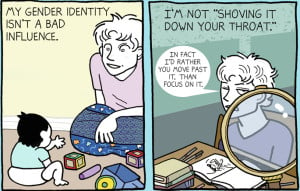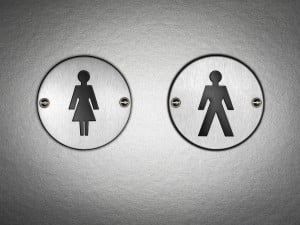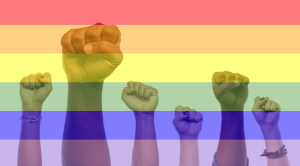
Source: Wallpaperist
Sexuality isn’t a choice. So it may seem confusing to some when people say they don’t label their sexuality or feel that their sexuality is fluid.
But being sexually fluid doesn’t mean a person is confused. For a person to know and accept their sexuality as fluid, they must be self-aware.
This isn’t to say that there aren’t some people, like barsexuals, who use the idea of sexual fluidity to play at homosexuality without having to deal with the stigma. But this article isn’t about them.
This article is about those who identify as bi, pan, queer, no labels, genderqueer, or any other identity that goes beyond the sexual identities normally covered by “gay” and “straight”.
These people are either always attracted to more than one gender or feel that their attraction may shift depending on factors like time, intimacy with certain partners, changes in hormone levels, and so forth.
So Is It Really Possible To Be Sexually Fluid?
Yup. Many people are familiar with the Kinsey Scale and how it functions with respect to bisexuality.
But what happens when we include sexual attraction to non-binary or genderqueer people?
And beyond that, do gay, straight, or bi accurately describe the sexuality of non-binary or genderqueer people themselves?
It’s important that we talk about how scientific studies show evidence of sexual fluidity, but the personal experiences of those who identify as sexually fluid are relevant as well.
Unfortunately, terms like “queer”, “pansexual”, or the outright rejection of labels haven’t quite caught on, even in the mainstream LGBTQIA+ movement.
People who try to explain their sexuality using these terms (or lack thereof) may be seen as attention seeking or “confused” because they don’t fit into a popular category.
But just because the language to describe sexuality is limited doesn’t mean that people don’t exist beyond those limits and self-label in a way that feels comfortable for them.
How Isn’t Sexual Fluidity A Choice?
Because even most sexually fluid person can’t wake up one morning and say, “Eh, I think I’ll dig guys now for the rest of my life.” Think of being sexually fluid the way you would any other type of fluid.
Fluid has no fixed shape, but it still has a fixed volume and consistency. So it may be with fluid sexuality—just because a person may prefer men right now doesn’t mean that will hold true for the rest of their life or even the rest of the week.
It may also be the case that some people are just wired to be more fluid and others are wired to have a more fixed sexual orientation. In either case, the person didn’t make a conscious decision about how they’d grow to express their sexuality.
So trying to goad a sexually fluid person into “picking a side” or “choosing a label” is as backwards as trying to convince a content gay man that he should “try” women to understand whether or not he’s really gay.
So Is It Confusing?
Depends on what you mean by confusing. As a sexually fluid person, I can say that I am not currently confused but have been in the past.
And by the past I mean puberty, the same period in life that confuses every human being who has ever experienced it.
If you mean that sexual fluidity is confusing to people who aren’t sexually fluid, then I guess that’s understandable.
I haven’t been in a lot of spaces where sexual fluidity was discussed as valid. So if sexual fluidity is confusing to people it may be due to a lack of visibility or the misconception that liking more than one gender requires polyamory and promiscuity.
So Sexually Fluid People Aren’t Just Being Greedy?
In short, no. Also, note that sexually fluid people can be attracted to the same amount of people (or more or less) as gay or straight people. Liking more than one gender isn’t the same thing as being extremely horny.
Sometimes people are hesitant to enter a relationship with someone who identifies as bi/queer/pan/no labels/etc. They may feel threatened by the possibility that the person will leave them for someone of another gender. They may not believe that sexually fluid people can be committed partners.
But I have to ask, why not? Straight people are attracted to more than one person, gay people are attracted to more than one person, the vast majority of people who experience sexual attraction are attracted to multiple people.
Being attracted to a greater variety of people — liking women and men when with a female partner for instance — does not make a person more likely to run off with someone else.
For the purpose of illustration, take my enjoyment of both pretzels and Nutella. Yes, pretzels and Nutella are two great tastes that go great together, but they don’t always have to go together. And when I’m munching a pretzel I’m not fantasizing about Nutella, and when I’m eating Nutella straight out of the jar (admit it, you’ve done it too) I don’t get the urge to add a pretzel to the mix.
When it comes to sexuality, just because a person can be attracted to more than one gender doesn’t mean they want to have sex with everyone all the time. There are varieties of people, gender being one of many variations, and not all sexually fluid people feel the need to experience every variety all the time. And those that do shouldn’t be given sh*t about it, because non-monogamy can work for them.
The hardest thing about understanding sexual fluidity is accepting that not every sexual identity out there is covered by a commonly heard label. Yes, we’ve come a long way from not even having a word for homosexuality, but there are still people who don’t have a word to comfortably define themselves. That’s why language and queer studies are constantly evolving.
That being said, don’t try to pressure someone into defining their sexuality in an effort to understand them or “help” them into picking a label. I’ve had moments where someone picked up on something I said and went, “AHA! So you prefer wo/men!” I can’t help but think that this reaction means the person is skeptical about how I define my sexuality and wants to put a “real” name to it that’s easier to understand.
But sexuality isn’t always easy to understand. As much as we humans love our binaries, they are way too black and white to encompass everything we can be. Yes, a large number of people are lesbians, gay men, straight men, and straight women.
But there are also fluid, bisexual, pansexual, queer, and questioning people, as well as people who say “meh” to all the labels. I know the LGBTQIA+ is getting a lot of letters attached to it, and it may seem unwieldy at times, but there was a time where even the first four letters didn’t have a place in society.
Maybe language will never catch up with everyone and everything. But we can still do our part to acknowledge the sexual identities that are less easily defined than others.
[do_widget id=”text-101″]
Jarune Uwujaren is a Contributing Writer for Everyday Feminism. A Nigerian-American recent graduate who’s stumbling towards a career in writing, Jarune can currently be found drifting around the DC metro area with a phone or a laptop nearby. When not writing for fun or profit, Jarune enjoys food, fresh air, good books, drawing, poetry, and sci-fi.
Search our 3000+ articles!
Read our articles about:
Our online racial justice training
Used by hundreds of universities, non-profits, and businesses.
Click to learn more




















